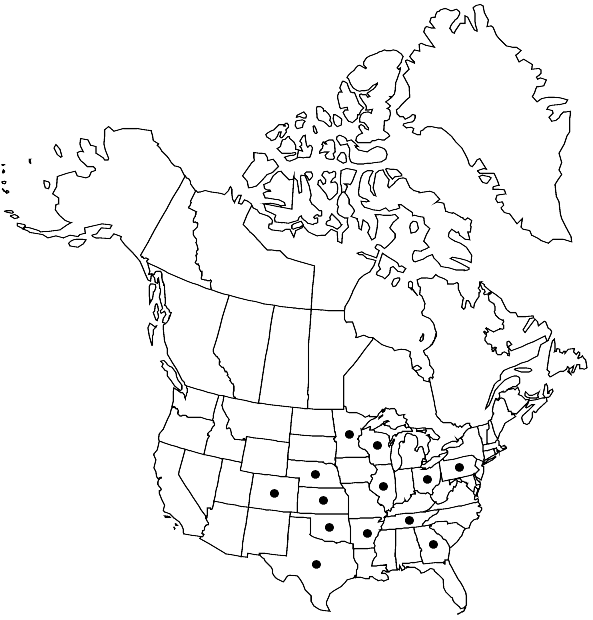Funaria americana
Öfvers. Kongl. Vetensk.-Akad. Förh. 20: 398. 1863,.
Plants 2–5 mm, pale olive green, stem with leaves crowded at the tip, and bearing a short antheridial branch at the base. Leaves larger distally and reduced proximally, distal leaves 2–3 mm, erect spreading, the blade elliptic to oblong-lanceolate or obovate gradually narrowed to a slender acumen, distal blade margins entire to weakly serrulate distally and entire proximally; costa narrowing distally and ending in the acumen; distal laminal cells thin-walled, rhomboid to oblong-hexagonal, somewhat narrowed at the margins, proximal cells becoming rectangular toward the base. Seta 6–10 mm, nearly straight. Capsule 1.5–2 mm, inclined, asymmetric, elongate-pyriform from a neck nearly as long as the spore sac, shrunken below the mouth but not plicate when dry; annulus none, operculum short-conic; peristome teeth lanceolate-triangular, dark yellow-brown, papillose-striate throughout, trabeculae distinct but moderately thickened, weakly appendiculate and extending into the tip; endostome segments about 3/4 the length of the teeth, triangular basally, narrowing midway to a slender tip, finely papillose. Calyptra cucullate, smooth. Spores 25–30 µm, somewhat angled, finely rugose-verrucate.
Habitat: Exposed calcareous soils among loosely tufted grasses or in moist bright disturbed habitats in early spring
Elevation: low to moderate elevations
Distribution

Ark., Colo., Ga., Ill., Kans., Minn., Nebr., Ohio, Okla., Pa., Tenn., Tex., Wis., Mexico.
Discussion
Funaria americana has been reported mainly from the area between the Appalachians and the Rocky Mountain divides, and it is reputed to be most likely encountered in disturbed microhabitats along river bluffs. Confusion has existed between the application of the names F. americana and F. muhlenbergii, as explained by H. A. Crum and L. E. Anderson (1981). Generally, collections from North America east of the Rockies continental divide belong to F. americana, and those from the western states belong to F. muhlenbergii, a species originally described from Europe. Such disjunctions are known for a number of genera and species of terrestrial plants. The costa extending nearly to the tip of the long leaf acumen is diagnostic. In F. muhlenbergii, the costa clearly ends before the short slender acumen.
Selected References
None.